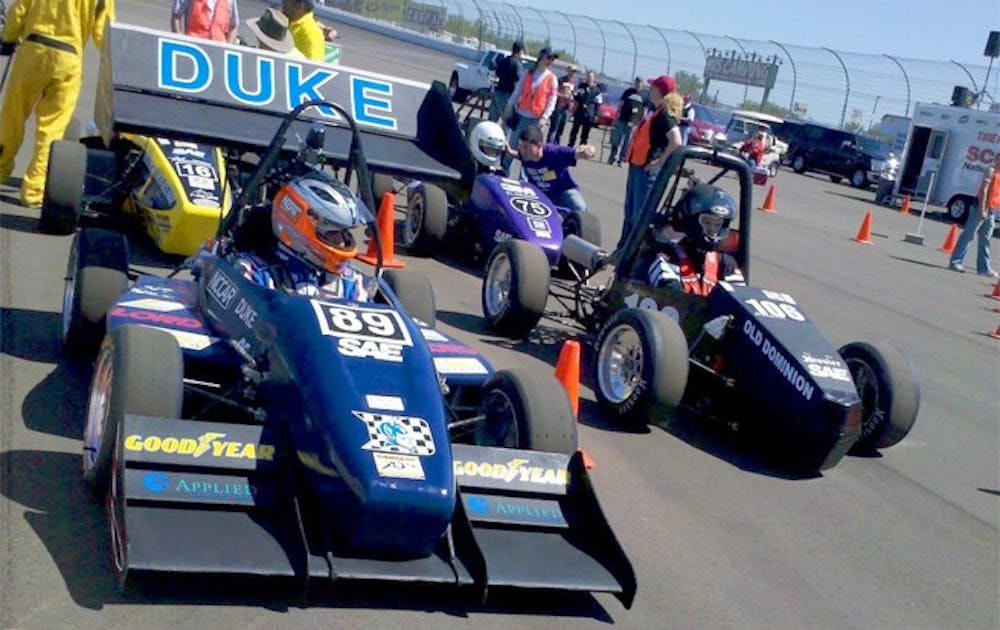Racce cars have put recent graduate on the fast track to a career in engineering.
Duke University Motorsports, a student group dedicated to designing and building race cars, took 12th place overall out of 118 registered teams at the Formula SAE—an international competition hosted by the Society of Automobile Engineers at the Michigan International Speedway in Brooklyn, Mich. in May. The group ranked in the top five of the American teams present, and its 12th place result tied the best finish in the group’s history. The competition involved various presentations and practical competitions based on a car the club members built from scratch.
“We had a plan this year, we had a timeline, we had a strong design,” said Michael Feng, Pratt ’10 and Master of Mechanical Engineering ’12. “I’m really happy with the way we did and the way we competed.”
Feng, who joined Duke University Motorsports during the Spring of his senior year, said he served as an overall technical leader for the club this year, overseeing the design and construction of the car.
The competition—which took place over the course of three days—judged more than the competing cars’ technical performance. Before competition began, each car was inspected to verify its compliance with the SAE handbook, said senior Costi Shami, a mechanical engineering student and participant. All teams were then judged on design, a business presentation making a case for the car’s viability with regard to manufacturing and marketing, and cost analysis.
“Every single nut and bolt and washer on the car has to be accounted for,” Shami said of the cost analysis report. “It’s a pretty hefty process.”
After the static portions of the competition, each car’s technical capability is put to the test. Cars compete in acceleration, where each car is driven on a skid pad in a figure-eight formation, autocross, which gauges the cars’ handling, fuel economy and endurance.
Faculty advisor Neal Simmons, assistant research professor of mechanical engineering and material science, said given the multitude of phases of competition, it is common that teams do not finish. He estimates that between one third and one half of participating teams successfully complete all portions of the competition.
“Lots of things break, lots of times you don’t pass technical inspection and you can’t go any farther,” Simmons noted.
The club spends the whole school year and much of the summer before preparing for the spring competition, Shami said. Preliminary designs for the car are created using SolidWorks, a computer-aided design software. Designs are often created by tweaking previous years’ designs by various degrees, but the club tries to come up with a holistic approach or general concept for each year’s car. This year the club focused on aerodynamics.
Next year, the club will focus again on aerodynamics and will seek to refine last year’s successful model, making particular efforts to decrease the car’s weight, Shami noted.
Sophomore Xavier de Gunten noted that he has already begun preparations for the upcoming year.
“Our goal this year is to really understand the theory behind the car,” de Gunten said. “ This summer I’ve been reading up on a lot of books, lots of textbooks.”
Five of the club’s senior members, including three graduate students, graduated in May, Shami noted. It will be a priority to train younger members and pass on relevant information so they can eventually spearhead production of the different aspects of the car, including the suspension, engine and frame.
Simmons said his role in the club is mostly hands-off, as the 10 to 15 core student members are highly motivated and knowledgeable in their own right. They also have developed a strong group dynamic based on mutual respect and admiration.
“It’s the dynamic you would probably expect from a highly driven group of individuals,” Simmons said. “They clearly sometimes have differences of opinion because it’s not always a clear right and wrong way to do things.”
Feng noted that one of the most rewarding aspects of the club is being able to see first-hand the real world applications of engineering. In fact, Duke Motorsports was the primary reason Feng returned to Duke for graduate school, and the club has provided a generous boost when it comes to job searching and resume building.
De Gunten added that the day-to-day experience is rewarding in itself.
“You’re putting in a lot of effort and you’re seeing the car being put together and at the end of the day, you get to see what you did,” he said.
Get The Chronicle straight to your inbox
Signup for our weekly newsletter. Cancel at any time.

